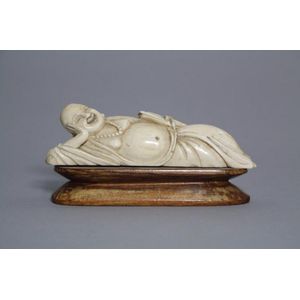Edwardian Marble Top Servery with Floral Carvings
You must be a subscriber, and be logged in to view price and dealer details.
Subscribe Now to view actual auction price for this item
When you subscribe, you have the option of setting the currency in which to display prices to $Au, $US, $NZ or Stg.
- Bow Front - The front is shaped in a gentle curve or bow. Introduced during the 18th century, the bow-front is associated with furniture of the Hepplewhite and Sheraton period, though of course the form continued to be used throughout the 19th century. Bow-fronted pieces are usually veneered, although some were cut from the solid wood. Where veneer is used, the carcase is cut either from pine or deal, or sometimes the front was built up and shaped with small timber 'bricks'. Commonly used on various types of furniture including chairs, settees, chests, side tables, sideboards and display cabinets.
- Frieze - An architectural term denoting the flat, shaped or convex horizontal surface of furniture, between the architrave and the cornice, usually found on a cabinet or bookcase, or on desks and tables where it may include drawers, the area between the top and the legs. In ceramics, the term refers to the banding, of usually a repeating pattern, on the rims of plates and vases.
- Edwardian - The Edwardian period of English furniture and decorative arts design is named for Edward VII (1841 ? 1910) who was King of the United Kingdom and the British Dominions and Emperor of India for the brief period from 1901 until his death in 1910. It follows the Victorian period, in turn was followed by the Art Nouveau and Art Deco styles. In Australia, designs of this period are also known as being in the Federation style.
- Bun Feet - Similar to ball feet, though somewhat compressed or flattened in appearance. Introduced during the late 17th century, but they have been used on furniture up to the present day.
- Panels - Timber pieces, usually of well-figured wood either recessed or applied over the frames of doors and as decoration elsewhere in the carcase of cabinet furniture. The panels may take a variety of shapes rectangular, square, shield shape, oval, half-round or in the form of Egyptian pylons.
- Swan Neck Pediment - Most commonly found on clocks, cabinets and bookcases, a swan neck pediment is formed by two flattened "S" shapes which almost meet in the centre. The form was derived from classical architecure and popularised by Chippendale in the 18th century. A true pediment is triangular in shape, and as a swan neck pediment does not meet at the apex of the triangle it is known as a "broken pediment". Swan neck pediments are also known as scrolled pediments.
This item has been included into following indexes:
Visually similar items

Fine antique or later carved ivory figure of a reclining Buddha, on wooden base, 14 cm long (ex Falk collection)

A set of six Victorian walnut drawing room chairs, each with a carved cresting rail and carved horizontal splat with stuff over seat on cabriole legs.

Good large antique brass repeater carriage clock maker Japy Freres, 19 cm including handle

A jade and diamond ring, the oval jade measuring 18 mm x 10 mm surrounded by baguette and brilliant cut diamonds. 18ct white gold. Weight 10.21gms. Size K.
